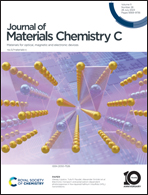Micro-/nanofiber-coupled superhydrophobic and conductive textile for underwater wearable strain sensors with full-scale human motion detection ability†
Abstract
Underwater sensing is important for healthcare and sports management monitoring in extreme water environments, where traditional strain sensors often fail. Therefore, we fabricated a superhydrophobic nanocoating wearable textile composite (SNWTC) strain sensor with exceptional liquid repellency, excellent strain sensing performance, and sensing stability in water environments. The conductive pathways in terms of direct overlapping and indirect contact of fluorinated MWCNTs in micro-/nanofiber-coupled network structures endowed the SNWTC surface with excellent conductivity. Also, the superhydrophobicity of the SNWTC was maintained after a series of mechanical and corrosion damage tests due to the synergistic enhancement between epoxy–silicone oligomers/polydimethylsiloxane and textile fibers. Importantly, the SNWTC strain sensor simultaneously achieved a wide sensing range (over 100% strain), superior sensitivity (a gauge factor of 949.5), low detection limit (strain ∼0.2%), and fast response time (∼100 ms) in air. Moreover, it could also efficiently monitor full-scale human motions in air and underwater with equally excellent sensitivity. Overall, the proposed textile composite strain sensor looks promising for divers’ extraordinary ocean exploration.



 Please wait while we load your content...
Please wait while we load your content...